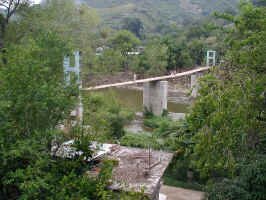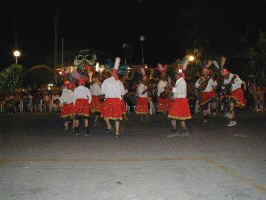October 31, 2004
Today we passed from one climatic zone to another. We left the high, dry area of San Luis Potosi and passed into the lush tropical area of the Huasteca area. We arrived at the village of Tamasopo, mainly a sugar cane growing area, and proceeded to the outstanding geologic feature, the Cascadas de Tamasopo. There are a number of different cascades and camps along this part of the river and we ended up at Aventuras Cabanas.
| We found this camp more or less by accident. We saw a sign for some cascades and turned off the highway on a dirt road. It turned out that the "road" was actually a track through the sugar cane fields barely wide enough for us to pass. We had to get out several times to check our clearance. When we found Aventuras, we knew we had come to the right spot. |
The owner, Charro, had cleared a place in the sugar came fields right on the river. We could swim and play on a series of small cascades. We decided to take out our kayak and Charro was kind enough to give us a ride up-river to launch it at the base of the falls called Puente de Dios.
Before launching however, another amigo we met at the campground, Bob, took us up to see the Puente de Dios "Bridge of God". The bridge is a rock formation similar to an arch where the river has eroded a large cave through which it passes through. The fun part was that in order to enter the cave and see the falls we had to jump in the river and swim upstream. It was a little bit overcast so we couldnít see the ray of light that often shines through the top of the cave. Don did swim up the far entrance of cave and peered through a curtain of water to see the falls on the other side.
Returning to the kayak, we scouted the immediate area, which was quite rocky, for a good place to launch. Deciding to skip the rapids at the put-in, we found a slow moving spot just up-river to take the kayak across to the other side. A friendly local helped Don carry the kayak over the rocks and I followed with the paddles.
Finally getting the kayak in the water, we started paddling downstream. Actually we didnít really have to paddle other than steering, the current was sufficient to carry us downstream at a good rate. The river was pretty shallow in some areas and we had to pass over a couple of the cascades but because the kayak has such a shallow draft we were able to find a pass through. Once or twice we got caught up, but for the most part it was a lovely float from the Puente back to the camping area.
After returning we received an invitation from Bob and his wife Suzanne to join them and some of their friends from Tamasopo. We spent a very nice evening with all of them.
†
November 2
We headed south today in the heart of the Huasteca Region to the town of Tamazunchale (Thomas-un-chalee) to participate in the Dias de los Muertos celebrations.
| Along the way we passed through small pueblos where we saw many typical Huasteca wood-slatted homes and in front of many of them were their traditional offrendas, or altars for the Day of the Dead.† Here you can see one home that has a trail of marigold petals for the souls to follow back home. |
These altars often consist of arches made up of green leaves, marigolds, fruit and breads. On the altar might be placed photos of the departed and their favorite foods or activities such as sweets, cigarettes and alcohol. We also noticed that the typical memorials along the road had been cleaned up and were decorated with the traditional marigolds.
Crossing over the Moctezuma River our first view of the town of Tamazunchale was of a hillside with very colorful small homes on it. On closer inspection, we realized these homes were the family tombs in the Panteon, the town cemetery. This was where we would be visiting later.
After finding a place to camp for the night, the proprietor steered us in the direction of a small village, walking distance from the campground. We crossed the river on a small suspension bridge and proceeded to walk through the village. The locals were very friendly and we were treated to views of their personal altars and paths strewn with marigold petals.
We then took a bus back across town to witness the celebrations of the local families around the tombs in the Panteon.
During the Day of the Dead, families come to the Panteon not to grieve but rather to celebrate the life of the deceased. They arrive with brooms and shovels to clean the graves, sometimes repainting or repairing broken crosses or name plates. Then they place decorations on the gravesite. The decorations can consist of garlands of marigolds, crosses of marigold petals, multiple candles, paper crosses or wreaths with religious icons.† Be sure to look at the photos and the slideshow for the 2004 Days of the Dead celebration.
Then many families have picnics with the departed. They bring the departedís favorite foods and share them by putting them on plates on the tomb. Tamales seem to be a staple of the food, together with fruit, and drinks Ė often alcohol. Sometimes they will even bring a band of Mariachis to perform, although we did not see any this time.
|
After sunset, we made our way back to the central Jardin to view traditional forklore celebrations of dance and music. The dance we viewed was called the Zacamson and is generally used to promote the growth of the sugar cane. The dances varied and used guitars or flutes and drums to accompany them. In one of the dances, the men carried sticks covered with bells and ribbons. The dances were very colorful and vibrant and added a special ending to a very special day.
† |

